|
Tour Code: EXP1
Discover remote temples, escape the crowds and experience ancient Khmer culture.
Itinerary: Siem Reap - Boeng Mealea - Siem Reap
Flight time: 36 minutes + ground: 60 minutes
Boeng Mealea
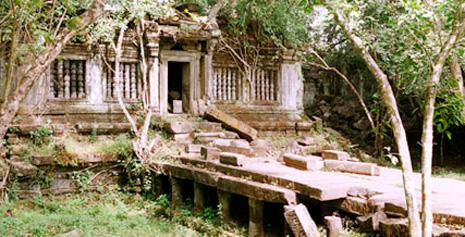 Boeng Mealea is a temple located 40 km east of the main group of temples at Angkor Wat and built during the reign of King Suryavarman II in the early 12th century. Its primary material is sandstone and it is surrounded by moats. The basic layout is three enclosing galleries around a central sanctuary. There is extensive carving of scenes from Hindu mythology, including the Churning of the Sea of Milk and Vishnu being borne by the bird god Garuda. Causeways have long balustrades formed by bodies of the seven-headed Naga serpent. Smaller in size than Angkor Wat, the king’s main monument, Boeng Mealea nonetheless ranks among the Khmer empire’s larger temples. Boeng Mealea is a temple located 40 km east of the main group of temples at Angkor Wat and built during the reign of King Suryavarman II in the early 12th century. Its primary material is sandstone and it is surrounded by moats. The basic layout is three enclosing galleries around a central sanctuary. There is extensive carving of scenes from Hindu mythology, including the Churning of the Sea of Milk and Vishnu being borne by the bird god Garuda. Causeways have long balustrades formed by bodies of the seven-headed Naga serpent. Smaller in size than Angkor Wat, the king’s main monument, Boeng Mealea nonetheless ranks among the Khmer empire’s larger temples.
Tour Code: EXP2
Discover remote temples, escape the crowds and experience ancient Khmer culture.
Itinerary : Siem Reap - Koh Ker - Beong Mealea - Siem Reap
Flight time: 1 hr 6 minutes + ground: 2 hours
Koh Ker:
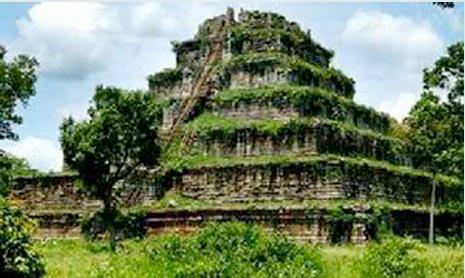 Koh Ker is 100 km northeast of Angkor Wat. It was briefly the capital of the Khmer empire between 928 and 944 under king Jayavarman IV and his son Hasavarman II. A vast number of temples were built under his reign, until his successor returned to the Angkor area about twenty years later. The Koh Ker site is dominated by Prasat Thom, a 30 meter tall temple mountain raising high above the plain and the surrounding forest. Currently, access to the top is closed. Koh Ker is very attractive for anyone who would like to experience lonely temples partially overgrown by the forest and inhabited only by birds, calling to each other from the trees above Koh Ker is 100 km northeast of Angkor Wat. It was briefly the capital of the Khmer empire between 928 and 944 under king Jayavarman IV and his son Hasavarman II. A vast number of temples were built under his reign, until his successor returned to the Angkor area about twenty years later. The Koh Ker site is dominated by Prasat Thom, a 30 meter tall temple mountain raising high above the plain and the surrounding forest. Currently, access to the top is closed. Koh Ker is very attractive for anyone who would like to experience lonely temples partially overgrown by the forest and inhabited only by birds, calling to each other from the trees above
Boeng Mealea
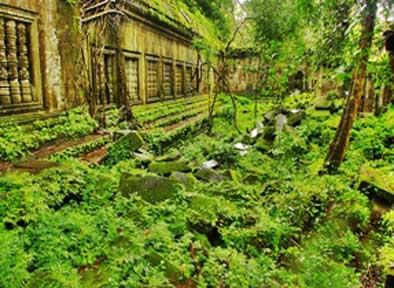 Boeng Mealea is a temple located 40 km east of the main group of temples at Angkor Wat and built during the reign of King Suryavarman II in the early 12th century. Its primary material is sandstone and it is surrounded by moats. The basic layout is three enclosing galleries around a central sanctuary. There is extensive carving of scenes from Hindu mythology, including the Churning of the Sea of Milk and Vishnu being borne by the bird god Garuda. Causeways have long balustrades formed by bodies of the seven-headed Naga serpent. Smaller in size than Angkor Wat, the king’s main monument, Boeng Mealea nonetheless ranks among the Khmer empire’s larger temples. Boeng Mealea is a temple located 40 km east of the main group of temples at Angkor Wat and built during the reign of King Suryavarman II in the early 12th century. Its primary material is sandstone and it is surrounded by moats. The basic layout is three enclosing galleries around a central sanctuary. There is extensive carving of scenes from Hindu mythology, including the Churning of the Sea of Milk and Vishnu being borne by the bird god Garuda. Causeways have long balustrades formed by bodies of the seven-headed Naga serpent. Smaller in size than Angkor Wat, the king’s main monument, Boeng Mealea nonetheless ranks among the Khmer empire’s larger temples.
Tour Code: EXP3
Discover remote temples, escape the crowds and experience ancient Khmer culture.
Itinerary: Siem Reap – Banteay Chhmar – Siem Reap
Flight time: 1 hr 12 minutes + ground: 45 minutes
Banteay Chhmar:
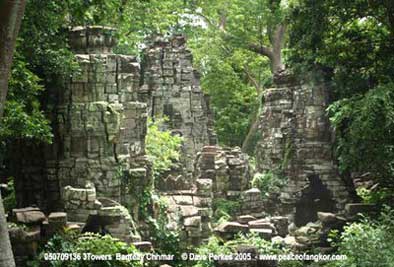 Banteay Chhmar is a large temple complex in Banteay Meanchey province in northwest Cambodia. It is located 63km north of Sisophon and fairly close to the Thai border. Banteay Chhmar was constructed during the reign of Jayavarman VII in the 12th and 13th century. The complex resembles Angkor Thom and other contemporary structures in many ways, from the causeway flanked by giants holding a snake to the towers with four faces. It is one of the least visited, studied, and protected temples from Cambodia’s Angkor period. Banteay Chhmar is a large temple complex in Banteay Meanchey province in northwest Cambodia. It is located 63km north of Sisophon and fairly close to the Thai border. Banteay Chhmar was constructed during the reign of Jayavarman VII in the 12th and 13th century. The complex resembles Angkor Thom and other contemporary structures in many ways, from the causeway flanked by giants holding a snake to the towers with four faces. It is one of the least visited, studied, and protected temples from Cambodia’s Angkor period.
Tour Code: EXP4
Discover remote temples, escape the crowds and experience ancient Khmer culture.
Itinerary: Siem Reap – Preah Vihear – Koh Ker – Siem Reap
Flight time: 1 hr 48 mins + ground: 4 hours
Preah Vihear:
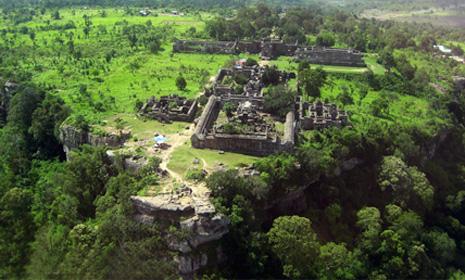 Preah Vihear is a Khmer temple situated atop a 525-metre cliff in the Dangrek Mountains in Cambodia close to the Thailand border, but most notably in Cambodian territory. As a key edifice of the empire’s spiritual life, it was supported and modified by successive kings and so bears elements of several architectural styles. Affording a view for many kilometers across a plain, it has the most spectacular setting of all the temples built during the six-century-long Khmer Empire. Long been the subject of intense ownership disputes between the two neighboring countries, Cambodia was officially awarded control of Preah Vihear in 1962 by the International Court of Justice and it is now listed as a UNESCO World Heritage Site. Preah Vihear is a Khmer temple situated atop a 525-metre cliff in the Dangrek Mountains in Cambodia close to the Thailand border, but most notably in Cambodian territory. As a key edifice of the empire’s spiritual life, it was supported and modified by successive kings and so bears elements of several architectural styles. Affording a view for many kilometers across a plain, it has the most spectacular setting of all the temples built during the six-century-long Khmer Empire. Long been the subject of intense ownership disputes between the two neighboring countries, Cambodia was officially awarded control of Preah Vihear in 1962 by the International Court of Justice and it is now listed as a UNESCO World Heritage Site.
Koh Ker:
 Koh Ker is 100 km northeast of Angkor Wat. It was briefly the capital of the Khmer empire between 928 and 944 under king Jayavarman IV and his son Hasavarman II. A vast number of temples were built under his reign, until his successor returned to the Angkor area about twenty years later. The Koh Ker site is dominated by Prasat Thom, a 30 meter tall temple mountain raising high above the plain and the surrounding forest. Currently, access to the top is closed. Koh Ker is very attractive for anyone who would like to experience lonely temples partially overgrown by the forest and inhabited only by birds, calling to each other from the trees above Koh Ker is 100 km northeast of Angkor Wat. It was briefly the capital of the Khmer empire between 928 and 944 under king Jayavarman IV and his son Hasavarman II. A vast number of temples were built under his reign, until his successor returned to the Angkor area about twenty years later. The Koh Ker site is dominated by Prasat Thom, a 30 meter tall temple mountain raising high above the plain and the surrounding forest. Currently, access to the top is closed. Koh Ker is very attractive for anyone who would like to experience lonely temples partially overgrown by the forest and inhabited only by birds, calling to each other from the trees above
Tour Code: EXP5
Discover remote temples, escape the crowds and experience ancient Khmer culture.
Itinerary: Siem Reap – Preah Vihear – Koh Ker – Boeng Mealea – Siem Reap
Flight time: 1 hr 54 minuts + ground: 5 hours
Preah Vihear:
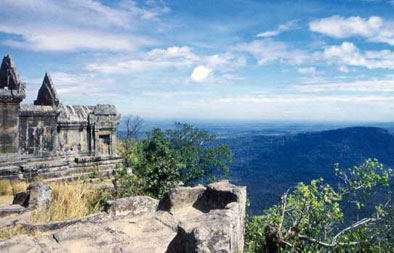 Preah Vihear is a Khmer temple situated atop a 525-metre cliff in the Dangrek Mountains in Cambodia close to the Thailand border, but most notably in Cambodian territory. As a key edifice of the empire’s spiritual life, it was supported and modified by successive kings and so bears elements of several architectural styles. Affording a view for many kilometers across a plain, it has the most spectacular setting of all the temples built during the six-century-long Khmer Empire. Long been the subject of intense ownership disputes between the two neighbouring countries, Cambodia was officially awarded control of Preah Vihear in 1962 by the International Court of Justice and it is now listed as a UNESCO World Heritage Site. Preah Vihear is a Khmer temple situated atop a 525-metre cliff in the Dangrek Mountains in Cambodia close to the Thailand border, but most notably in Cambodian territory. As a key edifice of the empire’s spiritual life, it was supported and modified by successive kings and so bears elements of several architectural styles. Affording a view for many kilometers across a plain, it has the most spectacular setting of all the temples built during the six-century-long Khmer Empire. Long been the subject of intense ownership disputes between the two neighbouring countries, Cambodia was officially awarded control of Preah Vihear in 1962 by the International Court of Justice and it is now listed as a UNESCO World Heritage Site.
Koh Ker:
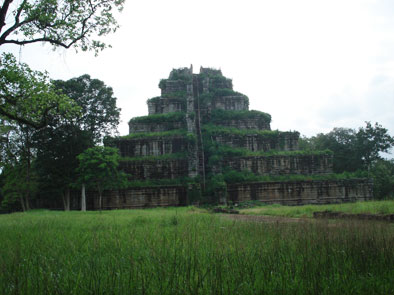 Koh Ker is 100 km northeast of Angkor Wat. It was briefly the capital of the Khmer empire between 928 and 944 under king Jayavarman IV and his son Hasavarman II. A vast number of temples were built under his reign, until his successor returned to the Angkor area about twenty years later. The Koh Ker site is dominated by Prasat Thom, a 30 meter tall temple mountain raising high above the plain and the surrounding forest. Currently, access to the top is closed. Koh Ker is very attractive for anyone who would like to experience lonely temples partially overgrown by the forest and inhabited only by birds, calling to each other from the trees above Koh Ker is 100 km northeast of Angkor Wat. It was briefly the capital of the Khmer empire between 928 and 944 under king Jayavarman IV and his son Hasavarman II. A vast number of temples were built under his reign, until his successor returned to the Angkor area about twenty years later. The Koh Ker site is dominated by Prasat Thom, a 30 meter tall temple mountain raising high above the plain and the surrounding forest. Currently, access to the top is closed. Koh Ker is very attractive for anyone who would like to experience lonely temples partially overgrown by the forest and inhabited only by birds, calling to each other from the trees above
Boeng Mealea
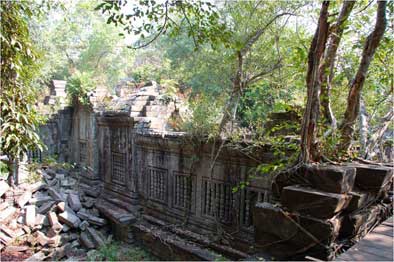 Boeng Mealea is a temple located 40 km east of the main group of temples at Angkor Wat and built during the reign of King Suryavarman II in the early 12th century. Its primary material is sandstone and it is surrounded by moats. The basic layout is three enclosing galleries around a central sanctuary. There is extensive carving of scenes from Hindu mythology, including the Churning of the Sea of Milk and Vishnu being borne by the bird god Garuda. Causeways have long balustrades formed by bodies of the seven-headed Naga serpent. Smaller in size than Angkor Wat, the king’s main monument, Boeng Mealea nonetheless ranks among the Khmer empire’s larger temples. Boeng Mealea is a temple located 40 km east of the main group of temples at Angkor Wat and built during the reign of King Suryavarman II in the early 12th century. Its primary material is sandstone and it is surrounded by moats. The basic layout is three enclosing galleries around a central sanctuary. There is extensive carving of scenes from Hindu mythology, including the Churning of the Sea of Milk and Vishnu being borne by the bird god Garuda. Causeways have long balustrades formed by bodies of the seven-headed Naga serpent. Smaller in size than Angkor Wat, the king’s main monument, Boeng Mealea nonetheless ranks among the Khmer empire’s larger temples.
Tour Code: EXP6
Discover remote temples, escape the crowds and experience ancient Khmer culture.
Itinerary: Siem Reap – Banteay Chhmar – Preah Vihear – Koh Ker – Boeng Mealea – Siem Reap
Flight time: 2 hrs 24 minutes + ground: 5 hours 45 minutes
Banteay Chhmar:
-small.jpg) Banteay Chhmar is a large temple complex in Banteay Meanchey province in northwest Cambodia. It is located 63km north of Sisophon and fairly close to the Thai border. Banteay Chhmar was constructed during the reign of Jayavarman VII in the 12th and 13th century. The complex resembles Angkor Thom and other contemporary structures in many ways, from the causeway flanked by giants holding a snake to the towers with four faces. It is one of the least visited, studied, and protected temples from Cambodia’s Angkor period. Banteay Chhmar is a large temple complex in Banteay Meanchey province in northwest Cambodia. It is located 63km north of Sisophon and fairly close to the Thai border. Banteay Chhmar was constructed during the reign of Jayavarman VII in the 12th and 13th century. The complex resembles Angkor Thom and other contemporary structures in many ways, from the causeway flanked by giants holding a snake to the towers with four faces. It is one of the least visited, studied, and protected temples from Cambodia’s Angkor period.
Preah Vihear:
 Preah Vihear is a Khmer temple situated atop a 525-metre cliff in the Dangrek Mountains in Cambodia close to the Thailand border, but most notably in Cambodian territory. As a key edifice of the empire’s spiritual life, it was supported and modified by successive kings and so bears elements of several architectural styles. Affording a view for many kilometers across a plain, it has the most spectacular setting of all the temples built during the six-century-long Khmer Empire. Long been the subject of intense ownership disputes between the two neighbouring countries, Cambodia was officially awarded control of Preah Vihear in 1962 by the International Court of Justice and it is now listed as a UNESCO World Heritage Site. Preah Vihear is a Khmer temple situated atop a 525-metre cliff in the Dangrek Mountains in Cambodia close to the Thailand border, but most notably in Cambodian territory. As a key edifice of the empire’s spiritual life, it was supported and modified by successive kings and so bears elements of several architectural styles. Affording a view for many kilometers across a plain, it has the most spectacular setting of all the temples built during the six-century-long Khmer Empire. Long been the subject of intense ownership disputes between the two neighbouring countries, Cambodia was officially awarded control of Preah Vihear in 1962 by the International Court of Justice and it is now listed as a UNESCO World Heritage Site.
Koh Ker:
 Koh Ker is 100 km northeast of Angkor Wat. It was briefly the capital of the Khmer empire between 928 and 944 under king Jayavarman IV and his son Hasavarman II. A vast number of temples were built under his reign, until his successor returned to the Angkor area about twenty years later. The Koh Ker site is dominated by Prasat Thom, a 30 meter tall temple mountain raising high above the plain and the surrounding forest. Currently, access to the top is closed. Koh Ker is very attractive for anyone who would like to experience lonely temples partially overgrown by the forest and inhabited only by birds, calling to each other from the trees above Koh Ker is 100 km northeast of Angkor Wat. It was briefly the capital of the Khmer empire between 928 and 944 under king Jayavarman IV and his son Hasavarman II. A vast number of temples were built under his reign, until his successor returned to the Angkor area about twenty years later. The Koh Ker site is dominated by Prasat Thom, a 30 meter tall temple mountain raising high above the plain and the surrounding forest. Currently, access to the top is closed. Koh Ker is very attractive for anyone who would like to experience lonely temples partially overgrown by the forest and inhabited only by birds, calling to each other from the trees above
Boeng Mealea
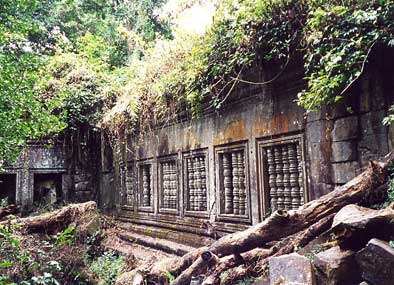 Boeng Mealea is a temple located 40 km east of the main group of temples at Angkor Wat and built during the reign of King Suryavarman II in the early 12th century. Its primary material is sandstone and it is surrounded by moats. The basic layout is three enclosing galleries around a central sanctuary. There is extensive carving of scenes from Hindu mythology, including the Churning of the Sea of Milk and Vishnu being borne by the bird god Garuda. Causeways have long balustrades formed by bodies of the seven-headed Naga serpent. Smaller in size than Angkor Wat, the king’s main monument, Boeng Mealea nonetheless ranks among the Khmer empire’s larger temples. Boeng Mealea is a temple located 40 km east of the main group of temples at Angkor Wat and built during the reign of King Suryavarman II in the early 12th century. Its primary material is sandstone and it is surrounded by moats. The basic layout is three enclosing galleries around a central sanctuary. There is extensive carving of scenes from Hindu mythology, including the Churning of the Sea of Milk and Vishnu being borne by the bird god Garuda. Causeways have long balustrades formed by bodies of the seven-headed Naga serpent. Smaller in size than Angkor Wat, the king’s main monument, Boeng Mealea nonetheless ranks among the Khmer empire’s larger temples.
|






 Boeng Mealea is a temple located 40 km east of the main group of temples at Angkor Wat and built during the reign of King Suryavarman II in the early 12th century. Its primary material is sandstone and it is surrounded by moats. The basic layout is three enclosing galleries around a central sanctuary. There is extensive carving of scenes from Hindu mythology, including the Churning of the Sea of Milk and Vishnu being borne by the bird god Garuda. Causeways have long balustrades formed by bodies of the seven-headed Naga serpent. Smaller in size than Angkor Wat, the king’s main monument, Boeng Mealea nonetheless ranks among the Khmer empire’s larger temples.
Boeng Mealea is a temple located 40 km east of the main group of temples at Angkor Wat and built during the reign of King Suryavarman II in the early 12th century. Its primary material is sandstone and it is surrounded by moats. The basic layout is three enclosing galleries around a central sanctuary. There is extensive carving of scenes from Hindu mythology, including the Churning of the Sea of Milk and Vishnu being borne by the bird god Garuda. Causeways have long balustrades formed by bodies of the seven-headed Naga serpent. Smaller in size than Angkor Wat, the king’s main monument, Boeng Mealea nonetheless ranks among the Khmer empire’s larger temples. Koh Ker is 100 km northeast of Angkor Wat. It was briefly the capital of the Khmer empire between 928 and 944 under king Jayavarman IV and his son Hasavarman II. A vast number of temples were built under his reign, until his successor returned to the Angkor area about twenty years later. The Koh Ker site is dominated by Prasat Thom, a 30 meter tall temple mountain raising high above the plain and the surrounding forest. Currently, access to the top is closed. Koh Ker is very attractive for anyone who would like to experience lonely temples partially overgrown by the forest and inhabited only by birds, calling to each other from the trees above
Koh Ker is 100 km northeast of Angkor Wat. It was briefly the capital of the Khmer empire between 928 and 944 under king Jayavarman IV and his son Hasavarman II. A vast number of temples were built under his reign, until his successor returned to the Angkor area about twenty years later. The Koh Ker site is dominated by Prasat Thom, a 30 meter tall temple mountain raising high above the plain and the surrounding forest. Currently, access to the top is closed. Koh Ker is very attractive for anyone who would like to experience lonely temples partially overgrown by the forest and inhabited only by birds, calling to each other from the trees above Boeng Mealea is a temple located 40 km east of the main group of temples at Angkor Wat and built during the reign of King Suryavarman II in the early 12th century. Its primary material is sandstone and it is surrounded by moats. The basic layout is three enclosing galleries around a central sanctuary. There is extensive carving of scenes from Hindu mythology, including the Churning of the Sea of Milk and Vishnu being borne by the bird god Garuda. Causeways have long balustrades formed by bodies of the seven-headed Naga serpent. Smaller in size than Angkor Wat, the king’s main monument, Boeng Mealea nonetheless ranks among the Khmer empire’s larger temples.
Boeng Mealea is a temple located 40 km east of the main group of temples at Angkor Wat and built during the reign of King Suryavarman II in the early 12th century. Its primary material is sandstone and it is surrounded by moats. The basic layout is three enclosing galleries around a central sanctuary. There is extensive carving of scenes from Hindu mythology, including the Churning of the Sea of Milk and Vishnu being borne by the bird god Garuda. Causeways have long balustrades formed by bodies of the seven-headed Naga serpent. Smaller in size than Angkor Wat, the king’s main monument, Boeng Mealea nonetheless ranks among the Khmer empire’s larger temples. Banteay Chhmar is a large temple complex in Banteay Meanchey province in northwest Cambodia. It is located 63km north of Sisophon and fairly close to the Thai border. Banteay Chhmar was constructed during the reign of Jayavarman VII in the 12th and 13th century. The complex resembles Angkor Thom and other contemporary structures in many ways, from the causeway flanked by giants holding a snake to the towers with four faces. It is one of the least visited, studied, and protected temples from Cambodia’s Angkor period.
Banteay Chhmar is a large temple complex in Banteay Meanchey province in northwest Cambodia. It is located 63km north of Sisophon and fairly close to the Thai border. Banteay Chhmar was constructed during the reign of Jayavarman VII in the 12th and 13th century. The complex resembles Angkor Thom and other contemporary structures in many ways, from the causeway flanked by giants holding a snake to the towers with four faces. It is one of the least visited, studied, and protected temples from Cambodia’s Angkor period. Preah Vihear is a Khmer temple situated atop a 525-metre cliff in the Dangrek Mountains in Cambodia close to the Thailand border, but most notably in Cambodian territory. As a key edifice of the empire’s spiritual life, it was supported and modified by successive kings and so bears elements of several architectural styles. Affording a view for many kilometers across a plain, it has the most spectacular setting of all the temples built during the six-century-long Khmer Empire. Long been the subject of intense ownership disputes between the two neighboring countries, Cambodia was officially awarded control of Preah Vihear in 1962 by the International Court of Justice and it is now listed as a UNESCO World Heritage Site.
Preah Vihear is a Khmer temple situated atop a 525-metre cliff in the Dangrek Mountains in Cambodia close to the Thailand border, but most notably in Cambodian territory. As a key edifice of the empire’s spiritual life, it was supported and modified by successive kings and so bears elements of several architectural styles. Affording a view for many kilometers across a plain, it has the most spectacular setting of all the temples built during the six-century-long Khmer Empire. Long been the subject of intense ownership disputes between the two neighboring countries, Cambodia was officially awarded control of Preah Vihear in 1962 by the International Court of Justice and it is now listed as a UNESCO World Heritage Site. Preah Vihear is a Khmer temple situated atop a 525-metre cliff in the Dangrek Mountains in Cambodia close to the Thailand border, but most notably in Cambodian territory. As a key edifice of the empire’s spiritual life, it was supported and modified by successive kings and so bears elements of several architectural styles. Affording a view for many kilometers across a plain, it has the most spectacular setting of all the temples built during the six-century-long Khmer Empire. Long been the subject of intense ownership disputes between the two neighbouring countries, Cambodia was officially awarded control of Preah Vihear in 1962 by the International Court of Justice and it is now listed as a UNESCO World Heritage Site.
Preah Vihear is a Khmer temple situated atop a 525-metre cliff in the Dangrek Mountains in Cambodia close to the Thailand border, but most notably in Cambodian territory. As a key edifice of the empire’s spiritual life, it was supported and modified by successive kings and so bears elements of several architectural styles. Affording a view for many kilometers across a plain, it has the most spectacular setting of all the temples built during the six-century-long Khmer Empire. Long been the subject of intense ownership disputes between the two neighbouring countries, Cambodia was officially awarded control of Preah Vihear in 1962 by the International Court of Justice and it is now listed as a UNESCO World Heritage Site. Koh Ker is 100 km northeast of Angkor Wat. It was briefly the capital of the Khmer empire between 928 and 944 under king Jayavarman IV and his son Hasavarman II. A vast number of temples were built under his reign, until his successor returned to the Angkor area about twenty years later. The Koh Ker site is dominated by Prasat Thom, a 30 meter tall temple mountain raising high above the plain and the surrounding forest. Currently, access to the top is closed. Koh Ker is very attractive for anyone who would like to experience lonely temples partially overgrown by the forest and inhabited only by birds, calling to each other from the trees above
Koh Ker is 100 km northeast of Angkor Wat. It was briefly the capital of the Khmer empire between 928 and 944 under king Jayavarman IV and his son Hasavarman II. A vast number of temples were built under his reign, until his successor returned to the Angkor area about twenty years later. The Koh Ker site is dominated by Prasat Thom, a 30 meter tall temple mountain raising high above the plain and the surrounding forest. Currently, access to the top is closed. Koh Ker is very attractive for anyone who would like to experience lonely temples partially overgrown by the forest and inhabited only by birds, calling to each other from the trees above Boeng Mealea is a temple located 40 km east of the main group of temples at Angkor Wat and built during the reign of King Suryavarman II in the early 12th century. Its primary material is sandstone and it is surrounded by moats. The basic layout is three enclosing galleries around a central sanctuary. There is extensive carving of scenes from Hindu mythology, including the Churning of the Sea of Milk and Vishnu being borne by the bird god Garuda. Causeways have long balustrades formed by bodies of the seven-headed Naga serpent. Smaller in size than Angkor Wat, the king’s main monument, Boeng Mealea nonetheless ranks among the Khmer empire’s larger temples.
Boeng Mealea is a temple located 40 km east of the main group of temples at Angkor Wat and built during the reign of King Suryavarman II in the early 12th century. Its primary material is sandstone and it is surrounded by moats. The basic layout is three enclosing galleries around a central sanctuary. There is extensive carving of scenes from Hindu mythology, including the Churning of the Sea of Milk and Vishnu being borne by the bird god Garuda. Causeways have long balustrades formed by bodies of the seven-headed Naga serpent. Smaller in size than Angkor Wat, the king’s main monument, Boeng Mealea nonetheless ranks among the Khmer empire’s larger temples.-small.jpg) Banteay Chhmar is a large temple complex in Banteay Meanchey province in northwest Cambodia. It is located 63km north of Sisophon and fairly close to the Thai border. Banteay Chhmar was constructed during the reign of Jayavarman VII in the 12th and 13th century. The complex resembles Angkor Thom and other contemporary structures in many ways, from the causeway flanked by giants holding a snake to the towers with four faces. It is one of the least visited, studied, and protected temples from Cambodia’s Angkor period.
Banteay Chhmar is a large temple complex in Banteay Meanchey province in northwest Cambodia. It is located 63km north of Sisophon and fairly close to the Thai border. Banteay Chhmar was constructed during the reign of Jayavarman VII in the 12th and 13th century. The complex resembles Angkor Thom and other contemporary structures in many ways, from the causeway flanked by giants holding a snake to the towers with four faces. It is one of the least visited, studied, and protected temples from Cambodia’s Angkor period. Boeng Mealea is a temple located 40 km east of the main group of temples at Angkor Wat and built during the reign of King Suryavarman II in the early 12th century. Its primary material is sandstone and it is surrounded by moats. The basic layout is three enclosing galleries around a central sanctuary. There is extensive carving of scenes from Hindu mythology, including the Churning of the Sea of Milk and Vishnu being borne by the bird god Garuda. Causeways have long balustrades formed by bodies of the seven-headed Naga serpent. Smaller in size than Angkor Wat, the king’s main monument, Boeng Mealea nonetheless ranks among the Khmer empire’s larger temples.
Boeng Mealea is a temple located 40 km east of the main group of temples at Angkor Wat and built during the reign of King Suryavarman II in the early 12th century. Its primary material is sandstone and it is surrounded by moats. The basic layout is three enclosing galleries around a central sanctuary. There is extensive carving of scenes from Hindu mythology, including the Churning of the Sea of Milk and Vishnu being borne by the bird god Garuda. Causeways have long balustrades formed by bodies of the seven-headed Naga serpent. Smaller in size than Angkor Wat, the king’s main monument, Boeng Mealea nonetheless ranks among the Khmer empire’s larger temples.